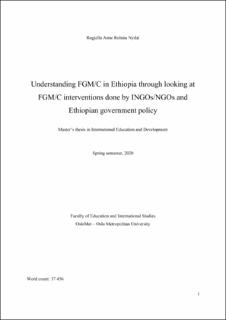| dc.contributor.advisor | Borchgrevink, Axel | |
| dc.contributor.author | Nydal, Rogjella Anne Roluna | |
| dc.coverage.spatial | Ethiopia | en_US |
| dc.date.accessioned | 2022-04-05T11:48:22Z | |
| dc.date.available | 2022-04-05T11:48:22Z | |
| dc.date.issued | 2020 | |
| dc.identifier.uri | https://hdl.handle.net/11250/2989939 | |
| dc.description.abstract | In order to build on the momentum achieved to date and in line with Sustainable Development Goal 5.3 on the elimination of child marriage, the government of Ethiopia launched a comprehensive National Roadmap to End Child Marriage and FGM/C in 2019. The World Health Organization (WHO) and UN agencies estimate that there are approximately 200 million women alive today that have experienced female genital mutilation/cutting (FGM/C) and another 68 million girls are at risk of being cut by 2030 if current trends continue. In a number of countries there has been a decline of the practice. Studies done on FGM/C indicate that the practice has changed in numerous ways. FGM/C is referred to as any procedure involving the alteration or excision of external female genitalia without medical indication. The WHO divides FGM/C into four different main types. There are various strong cultural justifications for the practice. FGM/C affects the social, psychosomatic, spiritual and physical well-being of women and girls. The 2016 EDHS is the most recent cross-sectional large-scale survey that measure FGM/C prevalence rates in Ethiopia. The 2016 EDHS data is substantial but can hide sub regional variations in prevalence. The EDHS show that there has been a decline in the prevalence, but changes in practice and decline are challenging to assess due to the complex nature of the practice. The practice of FGM/C differs from region to region in Ethiopia. The seven most common approaches used in FGM/C prevention are health risk education approaches, conversion of circumcisers, training of health-care professionals as agents of change, the creation of alternative rituals, community-led approaches, public statements, and legal method. Advocacy and coordinated work with government are also central approaches utilised. This thesis stresses that in understanding the context specific justifications for the practice within the hotspot FGM/C prevalent areas interventions done by the Ethiopian government or NGOs can be more effective. In the case of Ethiopia, the government has provided a policy framework to promote total abandonment of FGM/C, however the 2009 CSO limited and restricted various NGOs ability to work with FGM/C as a human rights violation and not simply an issue of health. This thesis emphases the importance of understanding FGM/C as a human rights related issue. This thesis concludes with progress can be achieved through contextualized interventions in cooperation with Ethiopian government actors and key local actors within the intervention areas. | en_US |
| dc.language.iso | eng | en_US |
| dc.publisher | OsloMet - Storbyuniversitetet | en_US |
| dc.subject | Female genital mutilation | en_US |
| dc.subject | Ethiopia | en_US |
| dc.subject | Ethiopian government policies | en_US |
| dc.subject | Female genital mutilation interventions | en_US |
| dc.title | Understanding FGM/C in Ethiopia through looking at FGM/C interventions done by INGOs/NGOs and Ethiopian government policy | en_US |
| dc.type | Master thesis | en_US |
| dc.description.version | publishedVersion | en_US |
| dc.source.pagenumber | 116 | en_US |
